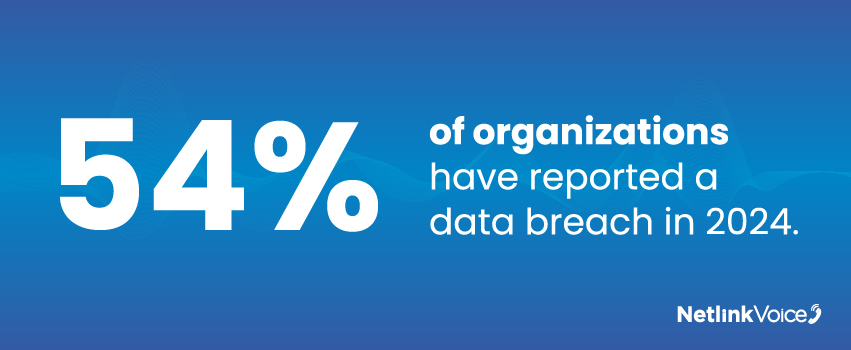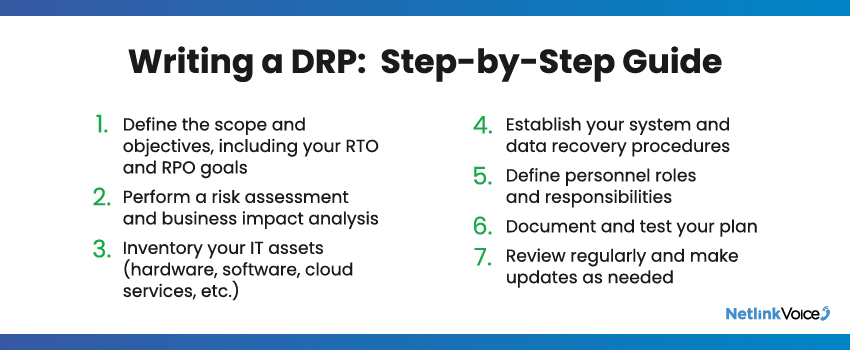From natural disasters and cyberattacks to equipment failures and beyond, modern businesses must be prepared to quickly recover their critical systems and data during a disaster. A 2024 survey found that 76% of business leaders recognize a gap in their data protection strategies.1 And with 92% of organizations planning to invest more in protecting their data,2 it’s clear that disaster recovery planning is top of mind for many.
Businesses without a well-documented disaster recovery plan in place often struggle to recover lost data and resume normal operations after a disaster strikes. This vulnerability can lead to financial losses, compliance issues, and irreparable damage to a company’s reputation. The stakes are high, and the need for disaster preparedness has never been more urgent.
In this blog, we’ll break down what a disaster recovery plan is and how to write one, along with some examples to help get you started.
What Is a Disaster Recovery Plan?
A disaster recovery plan (DRP) outlines the procedures and strategies an organization will follow to recover its systems, operations, and data after a disruptive event. These events can include natural disasters like earthquakes or hurricanes, as well as man-made incidents like cyberattacks or equipment failures.
Disaster recovery plans aim to minimize downtime and data loss, ensure rapid recovery of essential systems and data, and reduce financial and reputational damage to your business when a disaster occurs. Writing a disaster recovery plan and regularly testing it is essential for improving your business’s resilience – and ability to get through unexpected challenges unscathed.

9 Essentials for Your Disaster Recovery Plan
While no two disaster recovery plans are the same, there are some common components that every DRP should include. Here are nine essential elements to keep in mind when writing your disaster recovery plan:
Recovery Time Objectives (RTO) & Recovery Point Objectives (RPO)
RTO and RPO are critical metrics that guide your disaster recovery strategy.
- Recovery Time Objective (RTO): The maximum acceptable downtime for your systems and processes. RTO answers the question, “How quickly do we need to recover?”
- Recovery Point Objective (RPO): The maximum amount of data loss your business can tolerate. RPO answers the question, “How much data can we lose?”
Defining these objectives helps prioritize your recovery efforts and shapes the overall disaster recovery strategy. For example, a financial institution might have an RTO of four hours and an RPO of 15 minutes for its trading systems, while a small e-commerce business might set an RTO of 24 hours and an RPO of one hour for its website.
2. IT Assets Inventory
Maintain a comprehensive inventory of all your IT assets, including hardware, software, and data. Categorize these assets based on how important they are to your business operations. Critical assets are those your business can’t operate without, important assets are used at least once per day during normal operations, and non-critical assets won’t disrupt operations much if they’re unavailable.
Creating an inventory helps ensure no critical systems are overlooked in your disaster recovery plan. Include details like asset type and model, serial numbers, location, and dependencies on other systems, and regularly update this inventory as your IT infrastructure changes.
3. Data Backups
Over half (54%) of businesses have reported a data breach in 2024.3 Organizations run on data, so you need to dedicate a section of your IT disaster recovery plan to defining your data backup strategy. Include information like your backup methods, the frequency of backups, storage locations, and procedures for data protection and restoration.
You might also consider implementing a 3-2-1 backup strategy, which involves keeping three copies of your data in two different storage types, with one copy stored off-site. Regularly test your data backup and recovery strategies to ensure they work as expected when needed.

4. Redundant Infrastructure
Outlining how your business leverages redundant systems and infrastructure can help your IT teams maintain high availability and minimize downtime during disruptions. This may include duplicate servers, backup power supplies, or replicated storage devices.
As with your data backup plans, regularly test and maintain your redundant systems to make sure they work correctly when needed.
5. Disaster Recovery Sites
Specify where your company’s assets are located and where they will be moved in the event of a disaster. There are typically three types of disaster recovery sites:
- Hot Sites: Fully functional data centers with up-to-date customer data and IT equipment
- Warm Sites: Functional data centers with access to critical systems but without up-to-date customer data
- Cold Sites: Facilities used to store backups of systems or data that lack the ability to run operational systems
Clearly define which assets will be moved to which sites and the procedures for doing so. Consider factors such as the distance from your primary site, available resources at the recovery site, and the time required to move your data and systems to the site. Include detailed procedures for activating and transitioning to these recovery sites in your plan.
6. Disaster Recovery Procedures
Document the step-by-step procedures your staff will need to take when responding to different types of disaster scenarios. These should be clear, concise, and easy to follow during high-stress situations. Make sure to include:
- Initial response and assessment protocols
- Procedures for failing over to disaster recovery sites
- Steps for restoring critical systems and data
- Processes for verifying successful recovery
You can also create flowcharts or checklists to make these procedures easy to follow. Regularly review and update your disaster recovery processes so that they remain current and effective, and conduct drills to test and refine your procedures.
7. Personnel Roles
Clearly define who in the organization is responsible for various aspects of the disaster recovery strategy. Include:
- Names and contact details of personnel on your disaster recovery team
- Responsibilities for ongoing backups and maintenance of business continuity systems
- Authority for declaring a disaster
- Roles for contacting third-party vendors
- Responsibilities for reporting to management and liaising with customers and media
- Roles for managing the crisis and overseeing recovery efforts
Backup personnel should also be identified for each critical role. Update this information regularly to reflect personnel changes or organizational restructuring.
8. Communication Plan
Create a communication plan that outlines how information will be shared during and after a disaster. This should include internal communication protocols for employees and management, external communication procedures for customers, vendors, and partners, and guidelines for communicating with the media and public.
Establish a clear chain of communication and identify your primary and backup communication methods. For example, you might use a mass notification system for immediate communication with employees and set up a dedicated hotline or website to provide your customers with status updates.
9. Alternate Worksites
Identify alternative locations where your employees can work if the primary office becomes inaccessible. You’ll need to consider remote work capabilities, temporary office spaces, and procedures for quickly setting up workstations and accessing resources.
Detail the equipment your teams will need at an alternate site, such as:
- Laptops or mobile devices
- VPN access for secure remote connections
- Cloud-based productivity tools
- Temporary phone systems or call-forwarding services
Preparing alternate worksites can help reduce downtime and keep your business operational when a disaster occurs.
How To Write a Disaster Recovery Plan
Creating a disaster recovery plan can seem intimidating, but breaking it down into manageable steps simplifies the process. Here’s a guide to help you get started:

Define Objectives and Scope
Begin by clearly outlining the objectives of your disaster recovery plan. Consider:
- What are your priorities for recovery?
- What are your RTO and RPO goals?
- What critical applications and data need to be protected?
Next, define the scope of your plan. Determine which systems, applications, and data will be covered and to whom the plan applies (employees, contractors, specific departments). Your objectives might look something like “ensure the safety of all employees” or “restore critical business operations within four hours of a disaster.”
Perform a Risk Assessment
Risk assessments help you identify the risks and vulnerabilities your business might face that could lead to a disaster. This should include internal and external threats, including:
- Natural disasters like floods, earthquakes, and hurricanes
- Hardware failure or software crashes
- Human error incidents like accidental data deletion
- Cyberattacks or data breaches
- Infrastructure issues such as power outages or network failures
Performing a risk assessment is an important first step in determining how likely each risk is and its potential impact on your normal business operations, which can guide your disaster recovery strategies.
Perform a Business Impact Analysis
A business impact analysis (BIA) helps you identify your critical business functions, determine the potential financial and operational impacts of disruptions, and establish disaster recovery priorities based on how important each function is to your operations.
Consider factors like revenue loss per hour of downtime, contractual obligations, and regulatory compliance requirements. You can use this information to focus on the most important aspects of your business during recovery and allocate resources accordingly.
Inventory Your IT Assets
Create an inventory of your IT assets, including all hardware, software applications and licenses, data storage systems and backup solutions, and cloud services. Categorize these assets based on their criticality to business operations, and update this inventory when any changes are made to your IT infrastructure.
Establish Recovery Procedures
Develop detailed, step-by-step procedures for recovering your systems and data. This should include:
- Activation criteria for the disaster recovery plan
- Initial response and assessment protocols
- Procedures for failing over to backup systems or alternate sites
- Steps for restoring data from backups
- Processes for verifying successful recovery and returning to normal operations
Make sure these procedures are clear and easy to follow, as they may be carried out during high-stress scenarios.
Define Personnel Roles and Responsibilities
Outline the roles and responsibilities of your disaster recovery team. This section should also define the chain of command and decision-making authority, establish communication protocols between team members, and assign backup personnel for critical roles to ensure business continuity.
Consider creating a responsibility assignment matrix or RACI chart to clarify roles and responsibilities and update these assignments as needed to account for personnel changes or restructuring.
Document and Test the Plan
Compile the information you gathered in the previous steps into a comprehensive, easy-to-follow document. Your disaster recovery plan should include:
- An executive summary
- Scope and objectives of the plan
- Key contact information
- Detailed recovery procedures
- Communication protocols
- Resource requirements
Regularly test your DRP through tabletop exercises and full-scale drills. You can document the results of these tests and use them to refine and improve your strategies.

Review and Update Regularly
Set a schedule for reviewing and updating your disaster recovery plan. Consider changes in your IT infrastructure or business processes, lessons learned from tests or actual disruptive events, and new threats or vulnerabilities that may impact your business. Make sure all stakeholders are aware of updates to the plan and receive the appropriate training on any changes.
Disaster Recovery Plan Examples
Let’s take a look at disaster recovery plan examples from three major technology leaders: IBM, Google, and AWS. Each example can also serve as a disaster recovery plan template to help structure your own DRP.
IBM
IBM’s disaster recovery plan focuses on ensuring prompt response to any disaster or emergency impacting information systems. Its main sections include:
- Major goals of the disaster recovery plan
- Personnel information and organization chart
- Application and inventory profiles
- Data backup procedures
- Disaster recovery procedures
- Recovery plans for mobile and hot sites
- System restoration procedures
- Plan testing and evaluation guidelines
This approach emphasizes thorough documentation and clear procedures for various disaster recovery scenarios. IBM also recommends including checklists for each phase of the recovery process, from initial response to full restoration of services.
Google’s disaster recovery planning guide is built on a comprehensive approach to ensuring business continuity and fast recovery from disruptions. Key elements of their strategy include:
- Designing according to your recovery goals
- Implementing control measures
- Preparing your software
- Implementing security and compliance controls
- Verifying your disaster recovery security
- Meeting compliance requirements
- Making sure your DR plan works
Google’s approach focuses on building resilience directly into your IT infrastructure to reduce the impact on your business’s bottom when disaster strikes.
AWS
Amazon Web Services (AWS) provides a guide to cloud disaster recovery planning. Their approach focuses on prioritizing four elements:
- Data backup and restoration
- Replicating data from one location to another
- Replicating server-hosted applications and server-hosted databases
- Keeping a copy of your production environment in another location
This approach is meant to provide flexibility for businesses to choose the strategy that best fits their needs and budget.
Enhance Your Disaster Recovery Plan With Netlink Voice
A solid disaster recovery plan can protect your business from the potentially devastating effects of unexpected disruptions. By considering factors such as recovery time objectives, data backup strategies, and personnel roles, you can create a DRP that helps you minimize downtime, preserve critical data, and maintain business continuity – no matter what.
Netlink Voice offers cybersecurity services to help you develop and refine your disaster recovery plans. Our experts can conduct vulnerability assessments and penetration testing to uncover any gaps in your security posture, and we’ll help you close those gaps with cybersecurity solutions that give you peace of mind. Ready to kick your disaster recovery planning into gear? Reach out to Netlink Voice today.
Sources:

